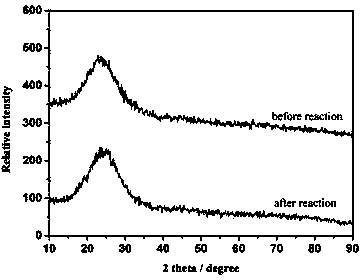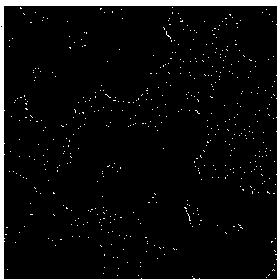Cu@mSiO2 core-shell nano catalyst for preparing hydrogen from ammonia borane and hydrazine borane by hydrolysis and preparation method of catalyst
A technology for hydrogen production by hydrolysis and hydrazine borane, which is applied in the direction of metal/metal oxide/metal hydroxide catalysts, chemical instruments and methods, physical/chemical process catalysts, etc. Catalytic performance and other issues to achieve the effect of avoiding the pre-modification process, mild reaction conditions, and avoiding performance degradation
- Summary
- Abstract
- Description
- Claims
- Application Information
AI Technical Summary
Problems solved by technology
Method used
Image
Examples
Embodiment 1
[0035] 1) Dissolve 20.16 g of surfactant polyethylene glycol mono-4-nonphenyl ether in 480 ml of non-polar solvent cyclohexane, and stir at room temperature for 2 hours.
[0036] 2) Add 2.16 ml copper chloride solution (concentration: 121.5 mM) dropwise to step 1) and stir for 15 hours.
[0037] 3) Add 2.16 ml concentrated ammonia water to step 2), and continue stirring for 2 hours.
[0038] 4) Add 3.6 ml tetraethyl orthosilicate to the reaction solution obtained in step 3), and continue to stir for 48 hours.
[0039] 5) Add the reaction solution obtained in step 4) to methanol solution for phase separation, then centrifuge, wash, and dry to obtain CumSiO with a core-shell structure loading of about 2.4 wt.%. 2 Core-shell structured nanocatalysts.
Embodiment 2
[0041] In Example 1, step 1) of polyethylene glycol mono-4-nonphenyl ether was changed to polyoxyethylene (20) hexadecyl ether, and other steps were the same as in Example 1 to obtain a core-shell structure with a loading capacity of about 2.4 wt.% CumSiO 2 Core-shell structured nanocatalysts.
Embodiment 3
[0043] In Example 1, step 1) polyethylene glycol mono-4-nonphenyl ether was changed to nonylphenol polyoxyethylene ether, and the other steps were the same as in Example 1 to obtain a core-shell structure with a loading capacity of about 2.4 wt.%. CumSiO 2 Core-shell structured nanocatalysts.
PUM
| Property | Measurement | Unit |
|---|---|---|
| particle diameter | aaaaa | aaaaa |
| particle diameter | aaaaa | aaaaa |
Abstract
Description
Claims
Application Information
 Login to View More
Login to View More - R&D
- Intellectual Property
- Life Sciences
- Materials
- Tech Scout
- Unparalleled Data Quality
- Higher Quality Content
- 60% Fewer Hallucinations
Browse by: Latest US Patents, China's latest patents, Technical Efficacy Thesaurus, Application Domain, Technology Topic, Popular Technical Reports.
© 2025 PatSnap. All rights reserved.Legal|Privacy policy|Modern Slavery Act Transparency Statement|Sitemap|About US| Contact US: help@patsnap.com



